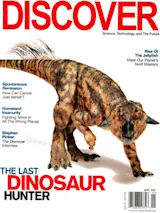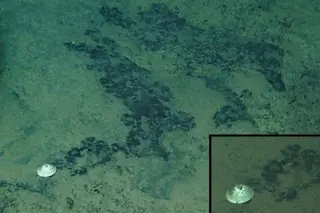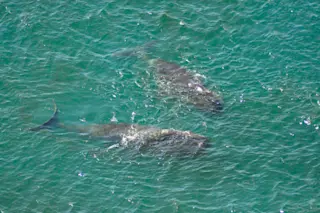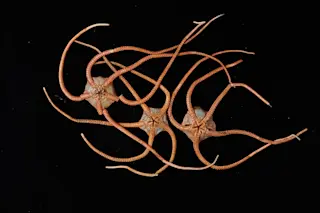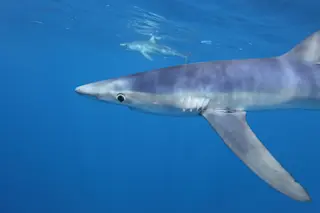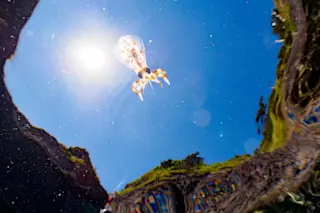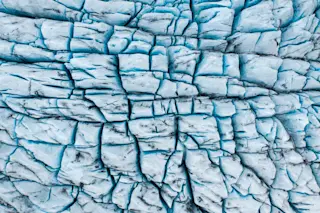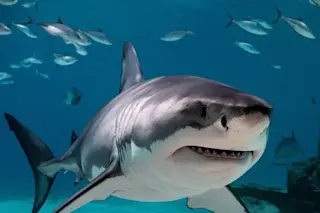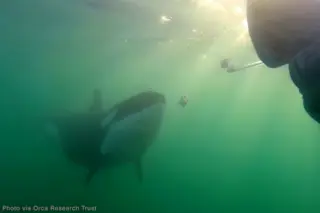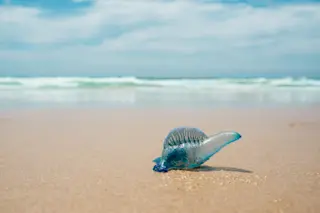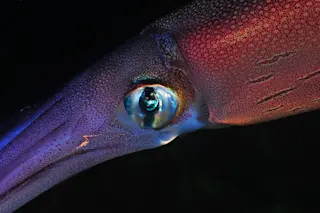A scientist doesn’t often fret that his research subjects might clog the ventilation system of his office. But Chad Widmer, 37, a senior aquarist at the Monterey Bay Aquarium just south of San Francisco, studies jellyfish, and along the world’s coasts, jellies seem to be exploding in size and number, pulsing through waters they haven’t ventured into before. In places like the Gulf of Mexico—where 60-pound blobs with 80-foot tentacles have appeared in recent years—the increasingly abundant creatures provoke mostly fear and disgust. To Widmer, though, everything about the jellies is fascinating. (He has a crystal jelly, the Aequorea victoria, tattooed on his left leg.) He especially wants to be able to predict their “blooms,” sudden spurts in the jelly population that can wreak havoc on fishermen’s nets or snarl a building—like the Monterey Bay Aquarium—whose operations depend on running seawater through it.
The aquarium stands on a part of the waterfront where John Steinbeck famously described boats brimming with fish. Within a decade of Cannery Row’s 1945 publication, though, the bay had been emptied of silver sardines, and now, a half century later, amid the jellyfish boom, something dire is happening to the bay once more. Over the past several years, Widmer says, salmon catches have “gotten worse and worse and worse,” while leatherback sea turtles, in order to find their food, have had to go “farther and farther offshore.” And the mola, a large sunfish that was once so abundant in Monterey Bay? “They’re just not here,” Widmer says. At first glance, even jellyfish would seem to be vanishing; in recent years the creatures have been more or less disappearing from the bay’s surface. Look deeper, though, and you’ll find a staggering diversity of these spectacular, tentacular creatures.
Along with the worries comes a rich set of scientific questions: Does the rise of the jellies (pdf) have something to do with the decline of the fish? What can jellyfish tell us about the health of the oceans? How will they fare as the oceans absorb more carbon dioxide from the air and become more acidic? Right now, no one knows. Across town at Monterey Peninsula College, Kevin Raskoff, who has investigated jellies in the Arctic, argues that for all their abundance, they are “probably the most alien life-form on the planet.” He still sees the animals as being, to a great extent, “a big black box. We know they’re there, but we don’t necessarily know what they’re doing.” Yet everything we have managed to learn about jellies in recent years “keeps pointing to how much more important they are than we thought,” Raskoff says. “There’s a long history of jellyfish really coming into huge numbers, big blooms, with a big effect on ecology, when you have perturbations to the system.” While perturbations can be part of a natural cycle, humans have been jostling the ocean ecosystem with dismaying gusto. We’ve been overfishing tuna and swordfish—some of the jellies’ predators—and the jellies seem to be responding.
At the Monterey Bay Aquarium Research Institute (MBARI), founded in 1987 by computer pioneer David Packard, veteran scientist Bruce Robison isn’t ready to make a primary-level link between jelly increases and global warming, but he’s certainly intrigued by the “second-, third-, or eighth-level connections.” Jellies, he says, “show us how the seas are changing, both naturally and in response to our own meddling.” We may not be putting jellies in charge of the oceans, but “we are giving them their shot at playing a bigger role by wiping out much of their competition,” he says. It’s their “broadly adaptable physiology” that will allow them “to outcompete more complicated animals for niches that become available because of warming, or acidification, or any number of reasons.”
So don’t blame the jellies. However many intake valves they clog or swimmers’ legs they sting, jellies aren’t turning the oceans acidic or warming them up. We are.
Jellyfish are not fish at all. They lack brains and spines, and yet they seem to exhibit a curious superiority, generating their own light and taking on guises almost ridiculously beyond classification. Siphonophores are jellyfish linked together to form what look like weaponized space platforms, while among the discrete medusae, moon jellies can appear both vegetal and artificial—purple pansies trapped under gauzy, throbbing petticoats. Brainless and bloblike though they may be, jellyfish “make a lot of different choices,” Widmer says: to seek the light or the dark; to spawn or not to spawn. They can sense food—zooplankton or fish larvae—in the distance and then cast out their tentacles to catch it.
Any scientist hoping to study jellies must reckon with a distinct set of obstacles. The creatures are too fragile to tag and monitor, so it’s hard even to know how long they live. Some probably last only several weeks, though Widmer has managed to keep a cohort of moon jellies alive for more than five years in one of the aquarium’s tanks. Only in the past two decades has what he calls “a revolution in collection techniques”—involving manned and remote-operated submersible vehicles—allowed researchers to bring intact specimens, instead of undifferentiated goo, back to their labs.
Yet for all that can be learned there, how much better it would be to know how jellies live and breathe, not in the glass tanks of human laboratories but in the ocean, where they actually reside. Knowing how much oxygen they use, for example, would indicate how much energy jellies require, how much prey they need to consume, and thus how big a player they are in the underwater food web.
To learn just how much jellies breathe in their native habitat, scientists from MBARI are setting off this morning in the
, one of the institute’s three research vessels. Leading the team is Robison, a native Californian who still bears traces of his surfer-boy youth beneath the lines of weathering. He has watchful blue eyes, an easy, cackling laugh, and an undiminished enthusiasm for the work he’s been doing for more than three decades.
After heading out a dozen or so miles into the bay, the MBARI researchers will release the ship’s submersible mini-me, the remote-operated Ventana. Tethered by a cable a half mile long, the vehicle will deliver a kettledrum-size unit called the Midwater Respirometry System (MRS) to the ocean floor, where it will record the respiration of the creatures it collects in its chambers. The depths of Monterey Canyon are, by Robison’s reckoning, the most studied part of any ocean in the world, and the Ventana, which is coming up on its 3,000th dive, has been in use here for two decades. Even so, scientists are still finding new animals there all the time. As for the jellies, Robison says that we’ve “grossly underestimated” their complexity, their numbers, and their fundamental importance to everything else living in the sea. In fact, he now believes that jellies make up at least a third of the oceans’ entire biomass.
The MBARI team’s principal task today is deploying the device that will measure the jellies’ breathing. Kim Reisenbichler, who is managing the experiment, explains that the MRS contains four separate chambers. After the experiment is lowered, the pilot maneuvers the MRS so that a jellyfish or other marine creature, as well as seawater, enters a chamber. Then the chamber’s door is closed. Sensors in the chambers measure the animals’ breathing by analyzing changes in oxygen concentration in the captured water.
When Reisenbichler began working with Robison 28 years ago, most marine biologists still trawled the ocean with nets. What they drew up often yielded no more than a lot of mush. Even now, in the age of submersibles, many of the jellies caught below 3,000 feet are so delicate that they do not survive to the surface or, if they do, they get damaged during transfer from one container to another.
While new methods of data collection are changing the kinds of questions scientists can ask about these delicate invertebrates, ultimately it is the jellies’ gaudy, Andromeda Strain–ish proliferation—the very thing that makes them such objects of fascination now—that will most likely speed up the study of them. As humans put stress on the habitats of more complicated marine creatures, Robison explains, “jellies, because they are relatively simple, cheap to build, and can reproduce very quickly, can respond to negative impacts on other kinds of animals by rushing in to fill their niche.”
So I’m compelled to ask: When it comes to global warming, are jellyfish the canaries in the mine shaft?
“No!” he answers, making me realize I’ve chosen a metaphor that’s right and wrong all at once. “They’re not dying; they’re moving in! They’re diggin’ it!”
With pilot D. J. Osborne working the controls from an electronic “belly pack” he’s got strapped to himself, the Ventana finally rises off the deck of the Point Lobos and gets lowered over the side. Reeling out a graceful curve of yellow cable, D. J. pushes the submersible a fair distance away from the ship before submerging it beneath the bay. In the ship’s control room, the team tracks what the rapidly descending Ventana has in front of its lens on a bank of video monitors. The image quality is as sharp as anything in the LCD aisles at your local Best Buy. White dots rise like champagne bubbles through the blue water, indicating the submersible’s downward progress. “Marine snow,” Reisenbichler notes, “a mucuslike substance filled with bacteria and fecal pellets.”
A plump, red jelly, with tentacles like the fringe on an ancient tearoom lampshade, enters the picture.
“Want to catch him?”
“We can always release him.”
“He’s pretty porky.”
“Put him in apartment three.” From there, for the next two days, the MRS will listen to him and some other new captives breathe.
“We’d better plant this sucker,” Robison says, and in another minute or two we’re just where we have to be to detach the MRS from the Ventana. The greenish-looking ocean floor, on which a starfish sits, suddenly rises into view. The base of the MRS stirs up the sand, and a curious sablefish collides with the device, provoking laughter.
Craig Dawe, the Ventana’s chief pilot, manipulates a mechanical claw to pull the cables off the automated instruments being left behind. Before our departure, the Ventana’s camera zooms in on the detached MRS, recording the exact coordinates we’ll return to, two days from now, to retrieve it. With that done, it’s time to reel the Ventana back up through the water to the Point Lobos. As it ascends, its camera notices a long line of yellow ink, and the control-room team starts to track a squid that’s eating a hard-bodied fish. The head of the prey is trapped inside the squid’s tentacles like a salmon that’s leapt? into the mouth of a bear.
When we head out two days later, the morning swells are just high enough to make me glad to have taken a couple of Dramamine. The Ventana will go down twice today, once to retrieve the MRS and then again to do some leisurely shopping for animals it can bring up in its separate collection canisters. Before long, the MRS comes into view, almost as if it were a piece of underwater wreckage being sought by Robert Ballard’s Titanic-hunting cameras. Somehow it looks as if it’s been down here for decades; the device’s cables, lying unattached on the ocean floor, now resemble tentacles.
Once the Ventana has captured the MRS and brought its cargo up on deck, the samples—including the porky red jelly, the Voragonema—are transferred to the ship’s lab, taken out of their canisters, and put into small plastic tubs. Back at MBARI, Reisenbichler will measure the animals and then “blot” them to get the water out. Next he will weigh and freeze them. Later the creatures will be analyzed for protein, lipids, and total carbon content. The last is a standard form of measurement that helps to quantify respiration, but there’s an additional, urgent aspect to such readings now. “We’re trying to assess the amount of carbon sequestered in the bodies of these animals as part of the ocean’s carbon budget, something that has not been done accurately before,” Robison says. The goal is a better appreciation of the huge role that jellies play in the marine food web, as well as a more complete inventory of how carbon (fundamental to both life and climate) is distributed in the ocean.
Unburdened of the MRS, the Ventana makes a second dive, ready to scoop up whatever looks scientifically interesting. A Solmissus, the huge spiderlike jellyfish on which Kevin Raskoff did part of his doctoral thesis, ventures in for a close-up. “See all this junk in here?” Robison asks, pointing to the creature’s see-through stomach. “That’s his lunch.” The Solmissus swims with its tentacles outward, hunting for prey instead of just waiting for it to blunder toward him. Only 20 years ago it was generally believed that jellies passively watched and waited for their next meal. Today, Robison says, “we know that there’s a whole group that hunts.” The youthfulness of the science comes to mind yet again when a red-striped Atolla swims into view. It really bugs him, Robison says, that we don’t know the purpose of the long white tentacle it sports amid a lot of other fringe. Some researchers think the appendage figures in reproduction; others believe it’s for catching prey.
For creatures much tougher than jellyfish—like the tongue-shaped, jelly-eating beroë that’s now nearby, its mouth resembling two fastened pieces of Velcro—the Ventana’s “suction sampler” is ready for action.
“OK,” Robison says. “Pump’s on.”
“Be gentle,” cautions Reisenbichler.
“Puree?” asks the pilot at the joystick.
“Liquefy!” Robison says, laughing, before the pilot captures it nicely intact. No wonder the jellyfish simply vanished in many earlier expeditions.
Weeks after the trip, Reisenbichler e-mails me the results of the MRS experiment. “While we do see some evidence of elevated oxygen consumption rates in situ for two out of the three species sampled during the last deployment, the sample numbers are too low to jump to any conclusions,” he says. Inconclusive but tantalizing, a suggestion that the jellies may indeed be doing more of everything down there. The best news of all may be word from Robison that the MRS equipment is performing “like a champ,” promising harder data ahead.
Yet a grim feeling pervades the aquatic realm. Later in the spring, Widmer tells me, “we would expect the sea lions to be ripping the top and bottom fins off the molas and throwing them around like Frisbees, skipping them on the surface. But they haven’t been doing it this year or last year or the year before”—because the molas are gone.
Widmer continues his work in a lab just 88 paces away from where Ed Ricketts, the real-life “Doc” of Cannery Row, did his—before the sardines lost their niche. Meanwhile, the proliferating jellies—breathing, multiplying, going below, moving in—seem to be following the tradition of pigeons, rats, and a handful of other adaptable creatures that prosper in our wake.
“If humans change the atmosphere and oceans to the detriment of other species,” Kevin Raskoff says, “and we find that jellies are filling in, we will have no one to blame but ourselves. The jellies are just doing what they have done for over 500 million years, and they are very, very good at it.” In a tragedy of our own making, the jellyfish, Raskoff declares, “will just be the messengers. Humans were the ones who wrote that message. We even had the chances to rewrite it over time but failed to take action.”
